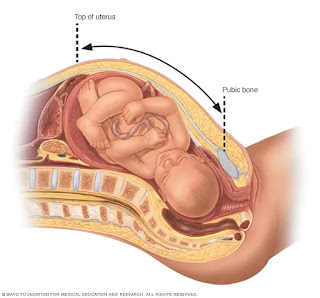- Before birth, measurement of the uterus and ultrasonography
- After birth, assessment of gestational age and size and weight of the baby
During pregnancy, doctors measure the distance on the woman's abdomen from the top of the pubic bone to the top of the uterus (fundus). This measurement, called the fundal height measurement, corresponds roughly with the number of weeks of pregnancy. For example, the normal fundal height for a woman who is 32 weeks pregnant is about 30 to 34 centimeters. If the measurement is low for the number of weeks, the fetus may be smaller than expected. |
| Fundal height measurement |
Ultrasonography can be done to assess the fetus's size and estimate the fetus's weight to confirm the diagnosis of small for gestational age. Ultrasonography may also be helpful in establishing the cause of the growth restriction and how it has affected the fetus. Depending on the findings, doctors may do genetic testing or magnetic resonance imaging (MRI) to determine the underlying cause.
After birth, small for gestational age is diagnosed by assessing the gestational age and the weight of the baby. Doctors measure the baby's length and head circumference to categorize the growth restriction as symmetric or asymmetric. Diagnostic tests, including ultrasonography, x-rays, MRI, tests for infection, blood tests, and genetic tests, and genetic tests, may be needed to find the cause of the growth restriction.



Comments
Post a Comment